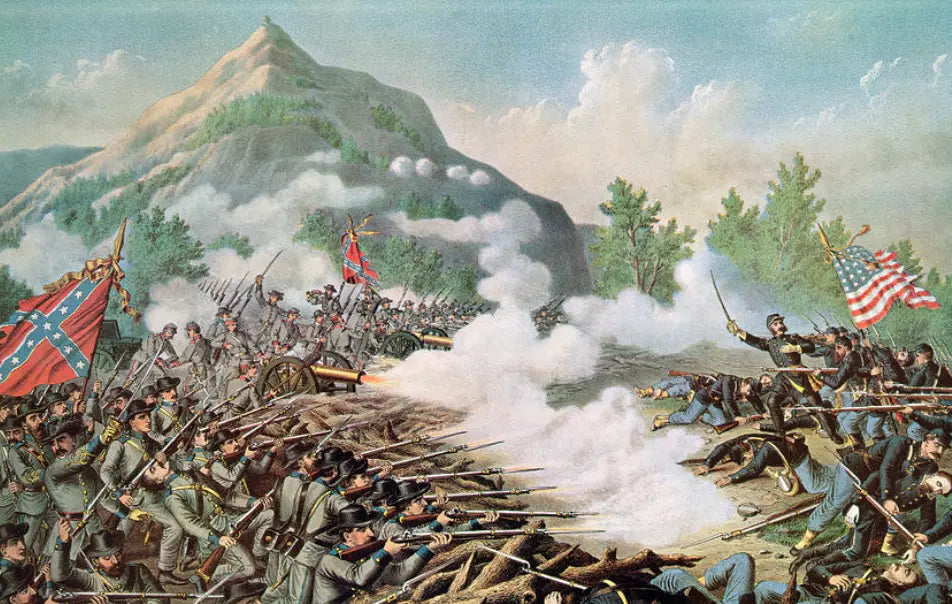With purchase of a Flagpole or Flagpole Kit until Labor Day!

“When our defeated line came back over the breastworks, I saw a brave color bearer marching erect with his teeth set, and the pallor of death spread over his face. In his left hand was gripped the flag of the regiment, which he was carrying to a place of safety, while his right arm was shot away with the blood streaming from a ragged stump. He held the colors erect until they reached their former position, then laid down and died.”
—Major Charles Dana Miller of the 76th Ohio Regiment in William T. Sherman’s Union Army at the Battle of Kennesaw Mountain
[Photo: Kennesaw Mountain, NPS]
June 27, 1864—the day on which the Battle of Kennesaw Mountain was fought—was not a good day for William T. Sherman’s approximately 100,000-man strong Union army. With Joseph E. Johnston’s perhaps 63,000-man strong Confederate Army of Tennessee entrenched both on Kennesaw Mountain and the elevated ground extending south from its twin peaks, beginning at 8:30 AM, Sherman launched two attacks. The first attack struck just north of the center of the Confederate line at the southern edge of Little Kennesaw and face of Pigeon Hill, while the second targeted just south of the same line’s center at Cheatham Hill. With each attack, Sherman aimed to cleave the Confederate army in two so that he might destroy it in detail.
[Photos: William T. Sherman and Jospeph E. Johnston]
In the first attack, between 5,000 and 6,000 troops from three XV Corps’ brigades braved merciless Southern artillery fire and pushed through dense thickets and undergrowth up the craggy slopes toward Little Kennesaw’s and Pigeon Hill’s crests. Awaiting them were Southerners from William H.T. Walker’s division of William Hardee’s Corps, entrenched behind log breastworks. When the Union infantrymen emerged from the foliage, the Confederates unleashed crippling musketry which decimated the ranks of the Federal attackers. The lucky Union survivors eventually received orders to retreat down the incline and dig in along the valley just west of the Confederate-dominated heights.
In the second and more famous attack, which began 30 minutes after and two miles south of where the first assault jumped off, barely shy of 10,000 Union soldiers from the IV and XIV Corps tromped through the woods and foliage just south of the Dallas Road and onto the ground, much of which was open, directly in front and just to the north and south of Cheatham Hill. Defending these heights were the Confederate divisions of Benjamin Cheatham (after whom the hill is named) and the Irishman Patrick Cleburne, both of which were parts of Hardee’s Corps.
While their comrades two miles to their north in the Union’s first attack of the day had suffered terribly, the Federals making the second attack advanced into an absolute maelstrom which was even more intense than those who made the first assault had experienced and suffered even higher numbers and proportions of casualties. This was primarily due to their formation and the geography of the Southern position. To strengthen the power of their troops’ collective punch, the Federal leaders in this sector of the battlefield had arrayed their soldiers in deep columns.
The goal of such a formation was to offer troops further back in the column the opportunity to strike the Southern defenses even if the enemy firepower blew the front ranks of the Union attacking force to smithereens. Tragically, however, these deep columns also turned the attackers into easy targets for Confederate artillerists. To make matters worse for the Federals, the ground in front of Cheatham Hill offered less natural protection than the ground in front of Pigeon Hill did.
Onward the blue-clad soldiers came, only to fall in droves to Confederate shrapnel, shells, and musketry. John Newton’s IV Corps’ division charged the Southerners of Cleburne’s division multiple times, but, in the end, all it had to show for the jaw-dropping bravery of its members was a staggering number of casualties, including a brigade commander shot dead from atop his horse. Just to the right and south of Newton’s division, Jefferson C. Davis’ XIV Corps’ Union division made for Cheatham Hill itself. Ultimately, its stalwart advance triggered the bloodiest and most famous mini saga of the entire battle: the fight for the crest of Cheatham Hill, or the “Dead Angle,” as it also became known to history.
[Photo: A Union Brigade Coming Face to Face with Cheatham’s Division at the Dead Angle, Credit to The Library of Congress]
As well as the more obvious fact that many soldiers died there, the Dead Angle derived its name from the lesser-known facts that, once they came within several yards of the Southern earthworks—which stood a whopping eight feet tall—the Federal troops occupied a “dead” zone in which they were invisible to the Confederate defenders just above them and that at this particular point the Confederate line jutted out at a slight angle to the west. Here, as the clock approached 11 AM, the Battle of Kennesaw Mountain quickly began to approach its climax.
After the war, the famed diarist Private Sam Watkins of the 1st Tennessee regiment in Cheatham’s Corps, which was defending the Dead Angle, remembered: “All of a sudden, our pickets jumped into our works and reported the Yankees advancing, and almost at the same time a solid line of blue coats came up the hill. I discharged my gun, and happening to look up, there was the beautiful flag of the Stars and Stripes flaunting right in my face.” At this point, a Confederate captain yelled to Watkins, “Look at that Yankee flag; shoot that fellow; snatch the flag out of his hand!” While Watkins does not mention whether he shot the Federal color bearer down, a close reading of Watkins’ memoirs leaves one with the distinct impression that he probably did.
[Photo: The First Tennessee’s Regimental Flag]
This brutal struggle in which Watkins partook resulted from Colonel Daniel McCook’s Union brigade of Davis’ division penetrating all the way to the imposing Confederate earthworks. Sherman’s junior law partner in Kansas before the war, McCook had inspired his soldiers to make the attack despite the clearly daunting, if not impossible, odds which faced them in the first place by reciting an excerpt from contemporary British epic poem about an Ancient Roman in a similar predicament. Today inscribed on a historical marker near Cheatham Hill, the words McCook—still three weeks shy of turning 32 years old—spoke to his men before leading them forward were these:
“To every man upon this earth
Death cometh soon or late.
And how can man die better
Than facing fearful odds,
For the ashes of his fathers,
And the temples of his Gods?”
Now within twenty yards of the Cheatham’s parapet, many of McCook’s still-standing troops stopped to fire back at the Confederates, who had already maimed or killed perhaps half of their comrades. Of these, the majority found themselves overwhelmed and shot down by the Tennesseans, but a few dozen of the hardiest of McCook’s survivors somehow managed to reach the “dead” zone just in front of the Confederate position. With the Southerners now unable to see them or fire down on them, these blue-clad soldiers had reached a position of relative safety.
Nevertheless, these Union soldiers were on a mission—and this mission was not, and never had been, to reach safety. Almost as soon as their bodies hit the dirt of the “dead” zone, they redoubled their efforts to scale Cheatham’s abatis, shoot or bayonet the Confederates holding the trench, and swamp the Southern position. Sadly for these Federals, their number was simply too few to render their lives anything but vain sacrifices in the quest to break Cheatham’s line.
Many members of McCook’s brigade were shot at point blank range as they tried to mount or fire over the Confederate parapet. This included McCook himself, shot in the chest and gravely wounded amongst the melee of Union and Confederate soldiers frantically slaughtering one another for control of this position so key to the integrity of the entire Southern line. The very few Federal survivors hugged the ground in the “dead” zone. Some did so for days, as retreating eight yards or advancing two yards meant certain death.
While grim, McCook’s fate was more dignified than that of so many of his unfortunate comrades: somehow rescued from the battlefield, he was taken home to Ohio and received word of his promotion to brigadier general five days before he died peacefully amongst family members on July 21, 1864–the day before what would have been his 32nd birthday. His former law partner, his commander Sherman, sang his praises from the time he heard of McCook’s fate until his own death in 1891. Nevertheless, with the other Union brigades’ attacks also coming to grief around the time of McCook falling, the Battle of Kennesaw Mountain was over.
[Photo: The Illinois Monument, Erected in 1914, Honoring McCook and Other Illinois Attacker at Kennesaw Mountain]
Tactically, the Battle of Kennesaw Mountain was undoubtedly a Confederate victory. While losing less than 1,000 of their own troops, the defending Southerners had inflicted approximately 3,000 casualties on the Union attackers and held every inch of their position. Strategically, however, the battle was not especially advantageous to either side. On July 2, Sherman simply moved around Johnston’s left flank, and the Confederate army retreated south toward Atlanta. This left the Union in control of Kennesaw Mountain for good. As Federal Private George Sharland of the 64th Illinois regiment recounted in his memoirs: “…The color bearer of our regiment was the first to plant the stars and stripes on [Kennesaw’s] lofty summit, and unfold the banner to the breeze, and ere the sun was reflected in the horizon, its graceful folds could be seen floating proudly on the mountaintop, from which the stars and bars had been previously ejected.”
[Photo: The American Flag Flying Proudly]
So, this was a relatively intense article with which to begin our series “American History Unfurled.” And perhaps it doesn’t say anything exactly profound. But if you want to take anything from it, take this: The next time you are driving past Kennesaw Mountain National Battlefield Park, take a moment to be grateful for national unity and our town’s fervent American patriotism. Things weren’t always this way, and we owe a tremendous debt of gratitude to the men who courageously performed their duties until their last breaths on that terrible day in June 1864 to help ensure we can enjoy the freedom and opportunities the American flag celebrates.
Further Reading:
Holmes, James T. (1915). Movements and Positions in the Battle of Kennesaw Mountain: The Memoir of
Colonel James T. Holmes, 52d Ohio Infantry. (Ed. by Garth E. Bishop). McFarland & Company, Inc.
Kiwanis Club of Marietta. 911: Field of Flags. https://www.911fieldofflags.com/
Sharland, George. (1865). Knapsack Notes of Gen. Sherman’s Campaign Through the Empire State of the South. Jackson and Bradford, Printers. https://catalog.hathitrust.org/Record/008733653
Vermilya, Daniel J. (2014). The Battle of Kennesaw Mountain.The History Press.
Watkins, Sam. (2025). “The Dead Angle: Private Sam Watkins’ Account of the Battle of Kennesaw Mountain.” American Battlefild Trust. https://www.battlefields.org/learn/primary-sources/dead-angle

